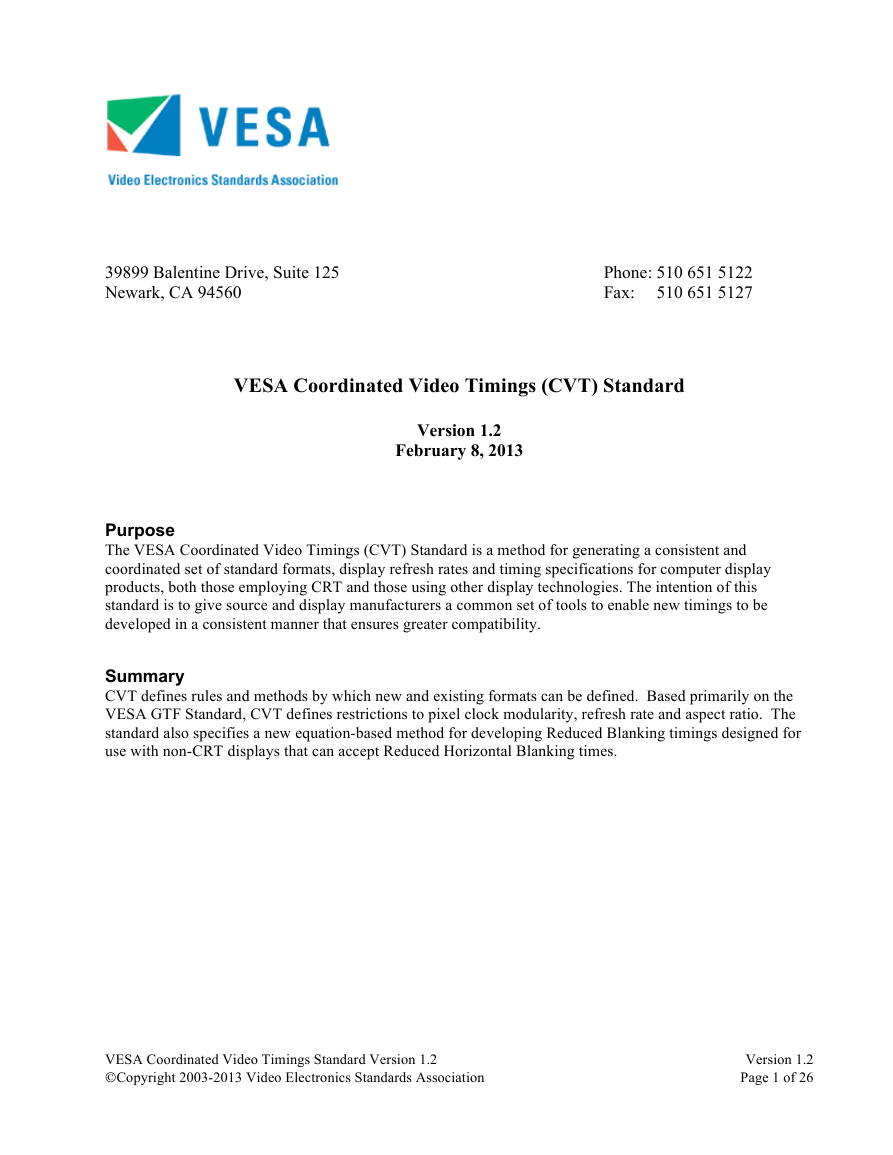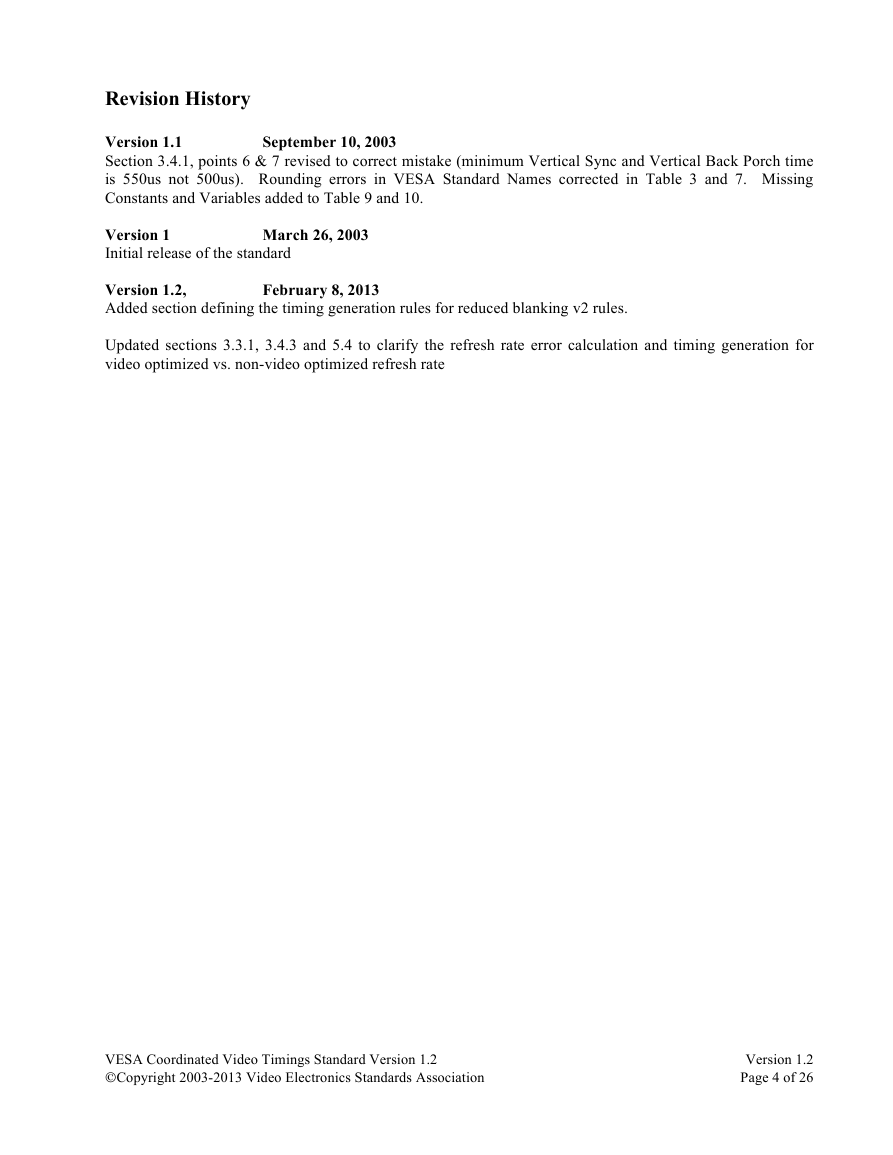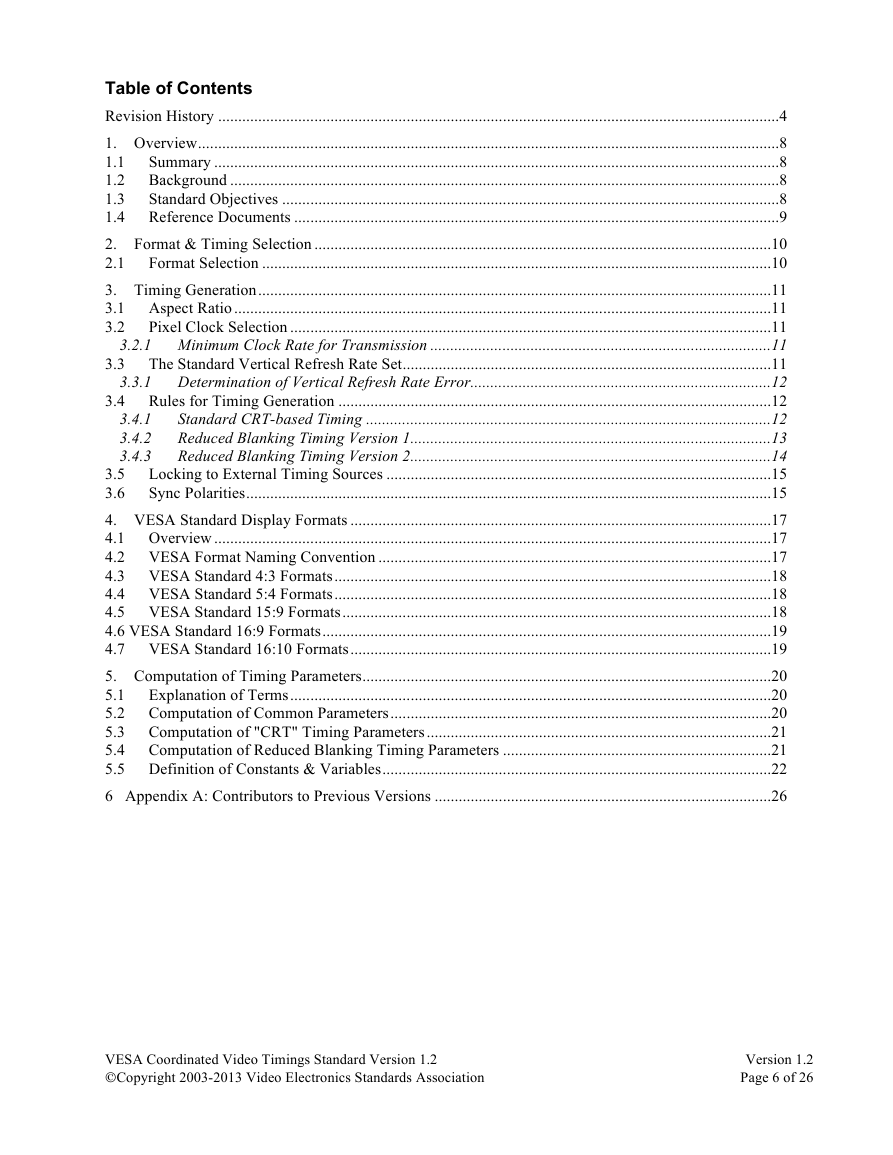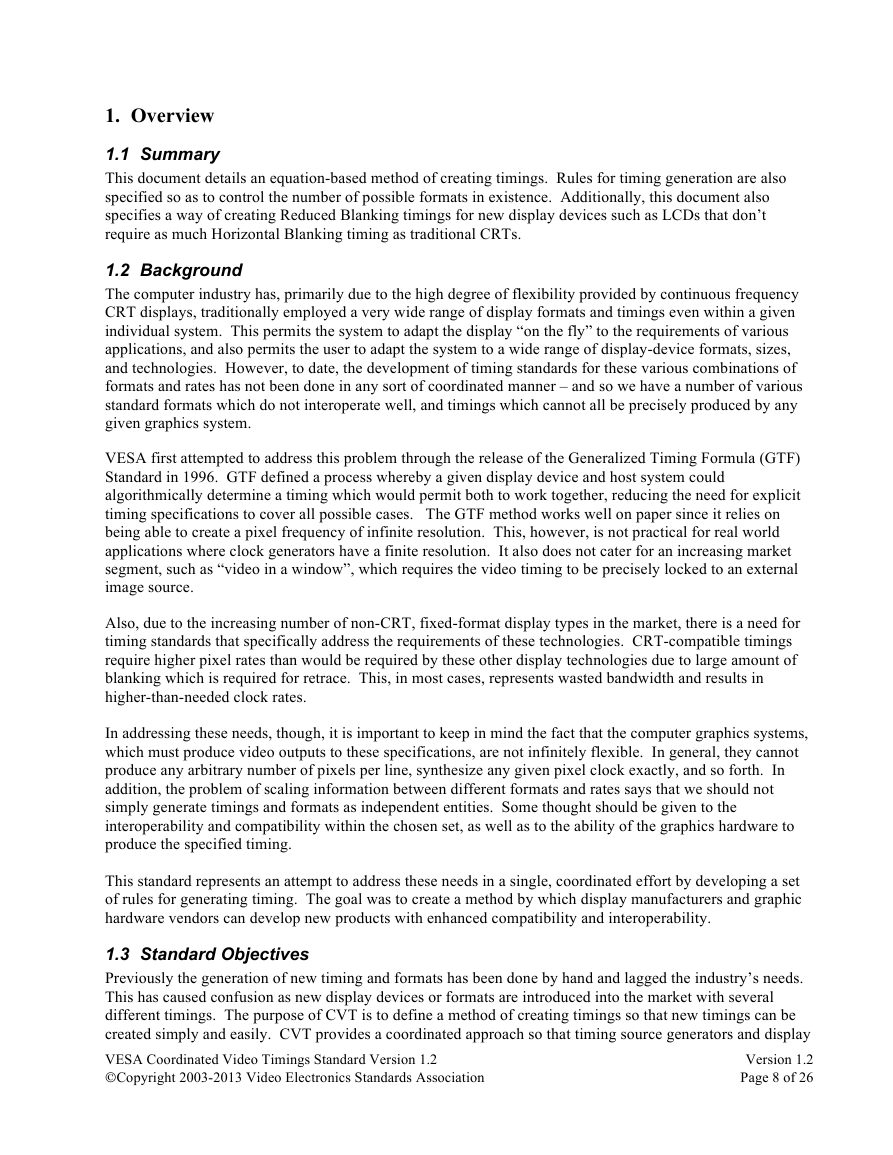39899 Balentine Drive, Suite 125
Newark, CA 94560
Phone: 510 651 5122
Fax: 510 651 5127
VESA Coordinated Video Timings (CVT) Standard
Version 1.2
February 8, 2013
Purpose
The VESA Coordinated Video Timings (CVT) Standard is a method for generating a consistent and
coordinated set of standard formats, display refresh rates and timing specifications for computer display
products, both those employing CRT and those using other display technologies. The intention of this
standard is to give source and display manufacturers a common set of tools to enable new timings to be
developed in a consistent manner that ensures greater compatibility.
Summary
CVT defines rules and methods by which new and existing formats can be defined. Based primarily on the
VESA GTF Standard, CVT defines restrictions to pixel clock modularity, refresh rate and aspect ratio. The
standard also specifies a new equation-based method for developing Reduced Blanking timings designed for
use with non-CRT displays that can accept Reduced Horizontal Blanking times.
VESA Coordinated Video Timings Standard Version 1.2
©Copyright 2003-2013 Video Electronics Standards Association
Version 1.2
Page 1 of 26
�
Preface
Intellectual Property
Copyright © 2003-2013 Video Electronics Standards Association. All rights reserved.
While every precaution has been taken in the preparation of this standard, the Video Electronics Standards
Association and its contributors assume no responsibility for errors or omissions, and make no warranties,
expressed or implied, of functionality or suitability for any purpose.
Trademarks
All trademarks used within this document are the property of their respective owners. EDID, E-EDID, DDC,
and VESA are trademarks of the Video Electronics Standards Association.
I2C is a trademark owned by Philips.
Patents
VESA draws attention to the fact that it is claimed that compliance with this standard may involve the use of a
patent or other intellectual property right (collectively, “IPR”) concerning CVT. VESA takes no position
concerning the evidence, validity, and scope of this IPR.
Attention is drawn to the possibility that some of the elements of this VESA Standard may be the subject of
IPR other than any identified above. VESA must not be held responsible for identifying any or all such IPR,
and has made no inquiry into the possible existence of any such IPR.
THIS STANDARD IS BEING OFFERED WITHOUT ANY WARRANTY WHATSOEVER, AND IN
PARTICULAR, ANY WARRANTY OF NON-INFRINGEMENT IS EXPRESSLY DISCLAIMED. ANY
IMPLEMENTATION OF THIS STANDARD MUST BE MADE ENTIRELY AT THE IMPLEMENTER’S
OWN RISK, AND NEITHER VESA, NOR ANY OF ITS MEMBERS OR SUBMITTERS, MUST HAVE
ANY LIABILITY WHATSOEVER TO ANY IMPLEMENTER OR THIRD PARTY FOR ANY DAMAGES
OF ANY NATURE WHATSOEVER DIRECTLY OR INDIRECTLY ARISING FROM THE
IMPLEMENTATION OF THIS STANDARD.
VESA Coordinated Video Timings Standard Version 1.2
©Copyright 2003-2013 Video Electronics Standards Association
Version 1.2
Page 2 of 26
�
Support for this Standard
Clarifications and application notes to support this standard may be written. To obtain the latest standard and
any support documentation, contact VESA.
If you have a product, which incorporates CVT, you should ask the company that manufactured your product
for assistance. If you are a manufacturer, VESA can assist you with any clarification you may require. All
comments or reported errors should be submitted in writing to VESA using one of the following methods.
• Fax :
•
• mail:
Technical Support
Video Electronics Standards Association
39899 Balentine Drive, Suite 125
Newark, CA 94560
510 651 5127, direct this note to Technical Support at VESA
e-mail:
support@vesa.org
VESA Coordinated Video Timings Standard Version 1.2
©Copyright 2003-2013 Video Electronics Standards Association
Version 1.2
Page 3 of 26
�
September 10, 2003
Revision History
Version 1.1
Section 3.4.1, points 6 & 7 revised to correct mistake (minimum Vertical Sync and Vertical Back Porch time
is 550us not 500us). Rounding errors in VESA Standard Names corrected in Table 3 and 7. Missing
Constants and Variables added to Table 9 and 10.
Version 1
Initial release of the standard
Version 1.2,
Added section defining the timing generation rules for reduced blanking v2 rules.
Updated sections 3.3.1, 3.4.3 and 5.4 to clarify the refresh rate error calculation and timing generation for
video optimized vs. non-video optimized refresh rate
February 8, 2013
March 26, 2003
VESA Coordinated Video Timings Standard Version 1.2
©Copyright 2003-2013 Video Electronics Standards Association
Version 1.2
Page 4 of 26
�
Acknowledgements
This document would not have been possible without the efforts of the VESA DisplayPort Task Group. In
particular, the following individuals and their companies contributed significant time and knowledge to this
version of the CVT Standard.
Table 1-0: Contributors to Version 1.2
Name
Syed Athar Hussain
David Glen
Quinn Carter
Greg Stewart
Colin Whitby-Strevens
Jamie Johnston
Mrinalini Attaluri
Jean-Jacques Ostiguy
David Stears
Craig Wiley
Mark Stockfisch
Alan Kobayashi
Prashant Shamarao
Company
AMD
AMD
AMD
Analogix Semiconductor
Apple
Intel
Intel
Matrox Graphics, Inc.
Nvidia
Parade Technologies
Quantum Data, Inc.
STMicroelectronics
Synaptics
Contribution
Document Editor
Task Group Chair
VESA Coordinated Video Timings Standard Version 1.2
©Copyright 2003-2013 Video Electronics Standards Association
Version 1.2
Page 5 of 26
�
3.3
3.4.1
3.4.2
3.4.3
Table of Contents
Revision History ............................................................................................................................................4
1. Overview .................................................................................................................................................8
1.1
Summary .............................................................................................................................................8
1.2 Background .........................................................................................................................................8
1.3
Standard Objectives ............................................................................................................................8
1.4 Reference Documents .........................................................................................................................9
2. Format & Timing Selection ..................................................................................................................10
2.1
Format Selection ...............................................................................................................................10
3. Timing Generation ................................................................................................................................11
3.1 Aspect Ratio ......................................................................................................................................11
3.2
Pixel Clock Selection ........................................................................................................................11
3.2.1 Minimum Clock Rate for Transmission .....................................................................................11
The Standard Vertical Refresh Rate Set ............................................................................................11
3.3.1 Determination of Vertical Refresh Rate Error ...........................................................................12
3.4 Rules for Timing Generation ............................................................................................................12
Standard CRT-based Timing .....................................................................................................12
Reduced Blanking Timing Version 1 ..........................................................................................13
Reduced Blanking Timing Version 2 ..........................................................................................14
Locking to External Timing Sources ................................................................................................15
3.5
3.6
Sync Polarities ...................................................................................................................................15
4. VESA Standard Display Formats .........................................................................................................17
4.1 Overview ...........................................................................................................................................17
4.2 VESA Format Naming Convention ..................................................................................................17
4.3 VESA Standard 4:3 Formats .............................................................................................................18
4.4 VESA Standard 5:4 Formats .............................................................................................................18
4.5 VESA Standard 15:9 Formats ...........................................................................................................18
4.6 VESA Standard 16:9 Formats ................................................................................................................19
4.7 VESA Standard 16:10 Formats .........................................................................................................19
5. Computation of Timing Parameters ......................................................................................................20
5.1
Explanation of Terms ........................................................................................................................20
5.2 Computation of Common Parameters ...............................................................................................20
5.3 Computation of "CRT" Timing Parameters ......................................................................................21
5.4 Computation of Reduced Blanking Timing Parameters ...................................................................21
5.5 Definition of Constants & Variables .................................................................................................22
6 Appendix A: Contributors to Previous Versions ....................................................................................26
VESA Coordinated Video Timings Standard Version 1.2
©Copyright 2003-2013 Video Electronics Standards Association
Version 1.2
Page 6 of 26
�
Tables
Table 3-1: Sync Polarities ............................................................................................................................15
Table 3-2: Vertical Sync Duration ...............................................................................................................16
Table 4-1: Examples of 4:3 Formats ............................................................................................................18
Table 4-2: Standard 5:4 Formats ..................................................................................................................18
Table 4-3: Standard 15:9 Formats ................................................................................................................18
Table4-4: Examples of 16:9 Formats ...........................................................................................................19
Table 4-5: Examples of 16:10 Formats ........................................................................................................19
Table 5-1: Expression Terms & Operator ....................................................................................................20
Table 5-2: Definition of Constants ...............................................................................................................22
Table 5-3: Definition of Variables ...............................................................................................................23
Table 5-4: Delta between Reduced Blank Timing and Reduced Blank Timing V2 ....................................24
VESA Coordinated Video Timings Standard Version 1.2
©Copyright 2003-2013 Video Electronics Standards Association
Version 1.2
Page 7 of 26
�
1. Overview
1.1 Summary
This document details an equation-based method of creating timings. Rules for timing generation are also
specified so as to control the number of possible formats in existence. Additionally, this document also
specifies a way of creating Reduced Blanking timings for new display devices such as LCDs that don’t
require as much Horizontal Blanking timing as traditional CRTs.
1.2 Background
The computer industry has, primarily due to the high degree of flexibility provided by continuous frequency
CRT displays, traditionally employed a very wide range of display formats and timings even within a given
individual system. This permits the system to adapt the display “on the fly” to the requirements of various
applications, and also permits the user to adapt the system to a wide range of display-device formats, sizes,
and technologies. However, to date, the development of timing standards for these various combinations of
formats and rates has not been done in any sort of coordinated manner – and so we have a number of various
standard formats which do not interoperate well, and timings which cannot all be precisely produced by any
given graphics system.
VESA first attempted to address this problem through the release of the Generalized Timing Formula (GTF)
Standard in 1996. GTF defined a process whereby a given display device and host system could
algorithmically determine a timing which would permit both to work together, reducing the need for explicit
timing specifications to cover all possible cases. The GTF method works well on paper since it relies on
being able to create a pixel frequency of infinite resolution. This, however, is not practical for real world
applications where clock generators have a finite resolution. It also does not cater for an increasing market
segment, such as “video in a window”, which requires the video timing to be precisely locked to an external
image source.
Also, due to the increasing number of non-CRT, fixed-format display types in the market, there is a need for
timing standards that specifically address the requirements of these technologies. CRT-compatible timings
require higher pixel rates than would be required by these other display technologies due to large amount of
blanking which is required for retrace. This, in most cases, represents wasted bandwidth and results in
higher-than-needed clock rates.
In addressing these needs, though, it is important to keep in mind the fact that the computer graphics systems,
which must produce video outputs to these specifications, are not infinitely flexible. In general, they cannot
produce any arbitrary number of pixels per line, synthesize any given pixel clock exactly, and so forth. In
addition, the problem of scaling information between different formats and rates says that we should not
simply generate timings and formats as independent entities. Some thought should be given to the
interoperability and compatibility within the chosen set, as well as to the ability of the graphics hardware to
produce the specified timing.
This standard represents an attempt to address these needs in a single, coordinated effort by developing a set
of rules for generating timing. The goal was to create a method by which display manufacturers and graphic
hardware vendors can develop new products with enhanced compatibility and interoperability.
1.3 Standard Objectives
Previously the generation of new timing and formats has been done by hand and lagged the industry’s needs.
This has caused confusion as new display devices or formats are introduced into the market with several
different timings. The purpose of CVT is to define a method of creating timings so that new timings can be
created simply and easily. CVT provides a coordinated approach so that timing source generators and display
VESA Coordinated Video Timings Standard Version 1.2
Version 1.2
©Copyright 2003-2013 Video Electronics Standards Association
Page 8 of 26
�
















 2023年江西萍乡中考道德与法治真题及答案.doc
2023年江西萍乡中考道德与法治真题及答案.doc 2012年重庆南川中考生物真题及答案.doc
2012年重庆南川中考生物真题及答案.doc 2013年江西师范大学地理学综合及文艺理论基础考研真题.doc
2013年江西师范大学地理学综合及文艺理论基础考研真题.doc 2020年四川甘孜小升初语文真题及答案I卷.doc
2020年四川甘孜小升初语文真题及答案I卷.doc 2020年注册岩土工程师专业基础考试真题及答案.doc
2020年注册岩土工程师专业基础考试真题及答案.doc 2023-2024学年福建省厦门市九年级上学期数学月考试题及答案.doc
2023-2024学年福建省厦门市九年级上学期数学月考试题及答案.doc 2021-2022学年辽宁省沈阳市大东区九年级上学期语文期末试题及答案.doc
2021-2022学年辽宁省沈阳市大东区九年级上学期语文期末试题及答案.doc 2022-2023学年北京东城区初三第一学期物理期末试卷及答案.doc
2022-2023学年北京东城区初三第一学期物理期末试卷及答案.doc 2018上半年江西教师资格初中地理学科知识与教学能力真题及答案.doc
2018上半年江西教师资格初中地理学科知识与教学能力真题及答案.doc 2012年河北国家公务员申论考试真题及答案-省级.doc
2012年河北国家公务员申论考试真题及答案-省级.doc 2020-2021学年江苏省扬州市江都区邵樊片九年级上学期数学第一次质量检测试题及答案.doc
2020-2021学年江苏省扬州市江都区邵樊片九年级上学期数学第一次质量检测试题及答案.doc 2022下半年黑龙江教师资格证中学综合素质真题及答案.doc
2022下半年黑龙江教师资格证中学综合素质真题及答案.doc